If you’ve ever imagined a cat that looks like it stepped straight out of a sci-fi movie, meet the Donskoy—Russia’s strikingly unique hairless feline. Known as the Don Sphynx or Russian Hairless, this breed combines an elf-like appearance with a playful, dog-like personality that will charm any cat lover.
From its distinctive coat types to its rare, loyal nature, the Donskoy is far more than just a hairless cat—let’s dive into everything you need to know about its price, care, lifespan and how it stacks up against the Sphynx.
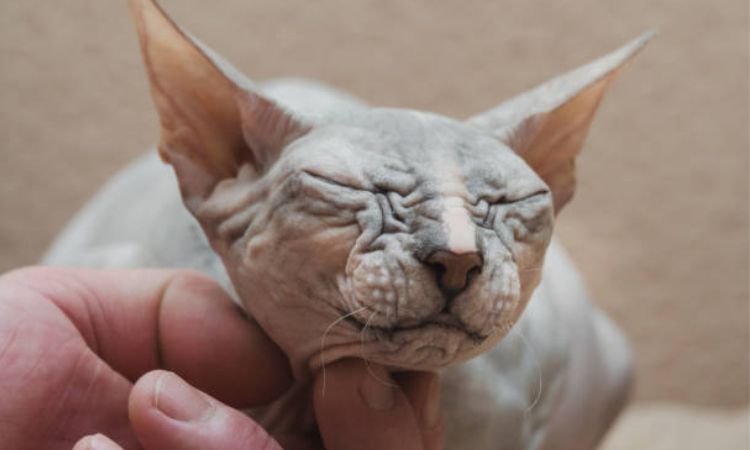
Donskoy Cat Overview
The breed started in 1987 in Rostov-on-Don, Russia, when breeder Elena Kovaleva rescued a blue tortoiseshell kitten named Varvara, who lost her fur as a kitten. Her hairless kittens became the foundation of the Donskoy breed. Recognized by the World Cat Federation in 1987 and TICA in 2005, the breed was later outcrossed with European Shorthairs to maintain genetic diversity.
Physical Characteristics
Donskoys are medium-sized, muscular cats with triangular heads, large ears, almond-shaped eyes, and soft, wrinkled skin. Eye colors vary widely, and some may grow a thin winter coat that sheds in warmer months. Four coat types exist:
- Rubber Bald: Fully hairless from birth.
- Flock: Fine, peach-fuzz-like coat that usually disappears.
- Velour: Wavy fur with a bald head spot; hair disappears within the first year.
- Brush: Sparse, wiry hair with bald patches.
They have long, webbed toes and strong, agile bodies.
Temperament and Personality
Donskoys are social, affectionate, and playful, often described as dog-like in loyalty. They enjoy games, mental stimulation, and interaction with humans and other pets. They are intelligent, trainable, and excellent with children. Donskoys do not tolerate long periods alone and thrive in attentive households.
Price of a Donskoy Cat
The Donskoy, also known as the Don Sphynx or Russian Hairless, is one of the rarest cat breeds in the world, and its price reflects that exclusivity. These cats are not only unique in appearance but also require careful breeding to maintain their health and distinctive hairless traits, which can influence their cost significantly.
Factors That Affect Price
- Age: Kittens typically cost more than adult cats because buyers often prefer to raise them from a young age. Older cats may be less expensive but might already have established personalities and health records.
- Pedigree and Bloodline: Donskoys with documented ancestry from championship lines or recognized breeders tend to command higher prices. Cats from show-quality bloodlines are particularly sought after.
- Breeder Reputation: Ethical breeders who follow responsible breeding practices, ensure genetic diversity, and provide proper veterinary care usually charge more. Avoiding kitten mills or unverified breeders is critical for both price and the cat’s well-being.
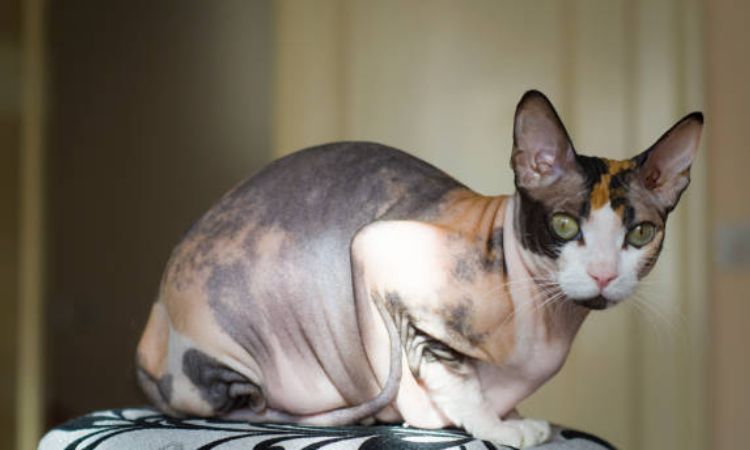
Average Price Range
- Globally: On average, a Donskoy kitten can cost anywhere from $1,200 to $3,500 USD, depending on the breeder, bloodline, and coat type. Some rare show-quality kittens may exceed $5,000 USD.
- Regionally: Prices vary by country due to availability, import costs, and local demand. In Europe and North America, the breed is particularly rare and often more expensive, whereas prices in Russia may be slightly lower due to local availability.
Additional Costs to Consider
Owning a Donskoy involves more than the initial purchase price. Potential owners should budget for:
- Veterinary Care:
- Initial vaccinations, deworming, and microchipping.
- Regular check-ups, dental cleanings, and preventive care.
- Spaying/Neutering:
- Essential if the cat is not intended for breeding; costs vary by region but typically range from $100 to $300 USD.
- Initial Supplies:
- Bedding, litter boxes, scratching posts, food and water dishes, and interactive toys.
- Specialty items such as sweaters for warmth and grooming supplies for skin care.
- Ongoing Costs:
- High-quality cat food, occasional vet visits, and skincare maintenance like monthly baths and ear cleaning.
The Donskoy is an investment not only in terms of purchase price but also in long-term care. Their rarity, unique genetics, and specialized care requirements contribute to the cost, making them ideal for committed cat enthusiasts who value their playful, social, and affectionate personalities.
Coat Types of the Donskoy Cat
The Donskoy cat is renowned for its distinctive hairless trait, a feature that sets it apart from most other breeds. Unlike the Sphynx, whose hairlessness results from a recessive gene, the Donskoy’s hairless condition is caused by a dominant genetic mutation. This means that kittens with the gene are either born hairless or gradually lose their fur as they mature. Hairlessness affects not only the Donskoy’s appearance but also its grooming needs, temperature sensitivity, and overall care.
Variations in Skin Texture and Appearance
While many Donskoys are entirely bald, the breed exhibits four recognized coat types:
- Rubber Bald – Completely hairless from birth and remains so throughout life. Their skin is smooth, soft, and warm to the touch, showing prominent wrinkles, especially around the head, neck, and shoulders.
- Flock Coat – Appears nearly hairless but has a very fine, peach-fuzz-like layer. Over time, most flock-coated Donskoys lose this fuzz, leaving fully exposed skin.
- Velour Coat – Born with a short, wavy coat and a bald spot on the crown. Hair gradually disappears within the first year, though some residual fuzz may remain on the face, tail, or legs.
- Brush Coat – Characterized by sparse, wiry, or bristly hair that partially persists, usually on the back, head, and neck. Brush-coated Donskoys are typically ineligible for cat shows due to the presence of partial hair.
In addition to coat type, skin color and patterning can vary, often showing subtle tones or mottling that give each cat a unique look. Some Donskoys may even develop a thin winter coat on the chest or tail, which is naturally shed as temperatures rise.
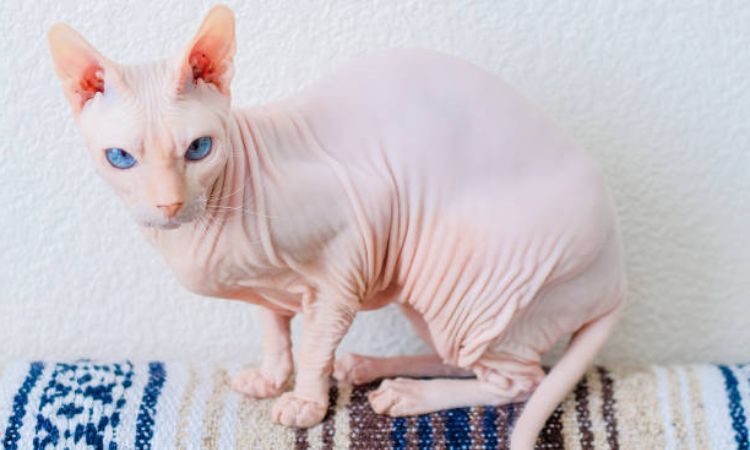
How Environmental Factors Affect the Coat
Environmental conditions play a significant role in the Donskoy’s coat and skin health:
- Temperature: Hairless Donskoys are sensitive to extreme cold and heat. In colder months, some may develop a light layer of fuzz, which disappears as temperatures warm.
- Sun Exposure: Without protective fur, their skin is prone to sunburn. Direct sunlight should be limited, and a veterinarian-approved sunscreen can be used if outdoor exposure occurs.
- Humidity and Skin Oils: Hairless cats produce natural oils that accumulate on the skin, leading to greasiness or potential irritation if not cleaned regularly.
Grooming Requirements for Different Coat Conditions
Despite minimal or absent hair, Donskoys require regular grooming to maintain healthy skin:
- Daily Wipe-Down: Use a damp cloth or gentle pet wipe to remove excess oils and prevent skin issues, especially for Rubber Bald and Flock coat types.
- Bathing: Monthly baths are generally recommended, though more frequent bathing may be necessary for Velour and Brush types to manage residual hair or oils.
- Ear Cleaning: Large ears tend to accumulate wax and debris, requiring weekly attention.
- Nail Care: Trim nails regularly to avoid overgrowth, and provide scratching posts for natural maintenance.
- Dental Care: Daily brushing helps prevent gum disease and tooth decay, which can be more common in hairless breeds due to genetic factors.
By understanding the different coat types, their textures, and the environmental influences that affect them, Donskoy owners can provide optimal care, ensuring both the skin and the overall health of these unique cats are well-maintained.
Lifespan and Health of the Donskoy Cat
The Donskoy cat is generally a healthy and long-lived breed, with an average lifespan of 12 to 15 years when provided with proper care. Their hairless nature gives them a distinctive look, but it also introduces some unique health considerations that potential owners should be aware of.
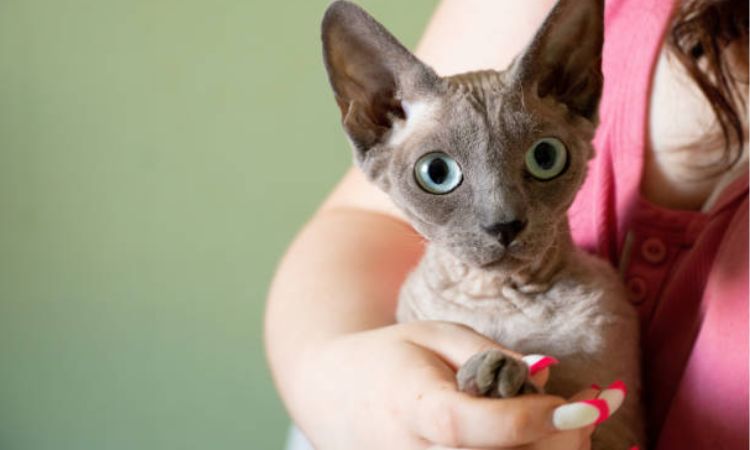
Lifespan Factors
Several factors influence a Donskoy’s longevity:
- Genetics: Reputable breeders who avoid inbreeding tend to produce healthier kittens with longer lifespans.
- Nutrition: A balanced, high-quality diet appropriate for the cat’s age and activity level supports overall health and longevity.
- Environment: Hairless cats are more sensitive to temperature extremes, so keeping them in a stable, comfortable indoor environment can prevent illness.
- Preventive Care: Regular veterinary check-ups, vaccinations, and dental care are crucial for identifying and addressing potential health issues early.
Common Health Considerations
While generally robust, Donskoys require attention to certain areas due to their hairlessness and active lifestyle:
- Skin Sensitivity
- Hairless cats like the Donskoy are prone to sunburn and skin irritation. Limiting direct sun exposure and using cat-safe sunscreen can prevent damage.
- Their skin produces natural oils that need regular cleaning to avoid buildup, which can lead to clogged pores or mild infections.
- Temperature Regulation
- Without a protective coat, Donskoys can become cold easily, especially in winter, or overheat in hot weather. Sweaters, blankets, or heated cat beds are helpful.
- Dental Health
- Like many cats, Donskoys are susceptible to dental issues such as plaque buildup and gum disease. Daily teeth brushing and routine veterinary dental exams are recommended.
- Nutritional Needs
- Donskoys often require slightly more calories than furred cats because they expend additional energy to maintain body warmth. During colder months, their food intake may need to be increased.
- Genetic Concerns
- The dominant gene responsible for hairlessness can, in rare cases, be associated with ectodermal dysplasia, which may affect teeth, nails, or sweat glands. Choosing a responsible breeder minimizes these risks.
Maintaining Optimal Health
- Regular Vet Visits: Schedule wellness checks at least annually, or more frequently for kittens and senior cats.
- Skin Care: Wipe down the cat’s skin daily and bathe as needed, typically once every 1–2 weeks.
- Dental Care: Brush teeth regularly and provide dental treats or toys to maintain oral health.
- Environmental Comfort: Ensure the cat has warm resting spots in winter and shaded, cool areas in summer.
- Mental & Physical Stimulation: Active and intelligent, Donskoys need interactive play and enrichment to prevent boredom and support overall well-being.
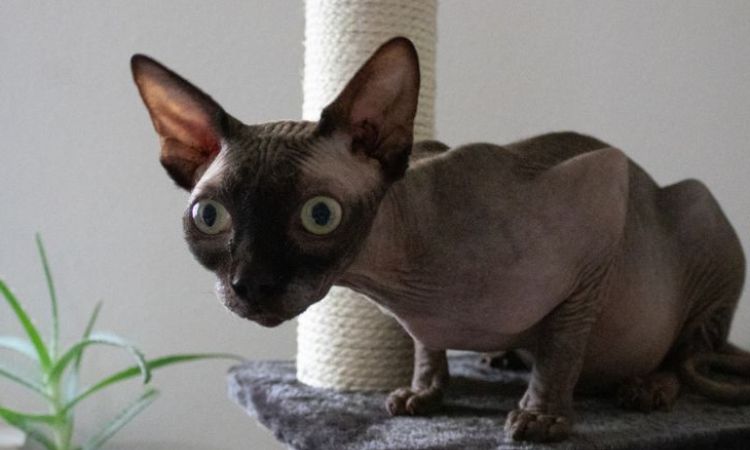
Comparison to the Sphynx Cat
The Donskoy and Sphynx cats are two of the most well-known hairless cat breeds, both admired for their distinctive appearance and affectionate personalities. While they share some similarities, there are important differences in genetics, care needs, and overall health.
Similarities
- Hairlessness: Both breeds are primarily hairless, which contributes to their striking, exotic appearance. Some Donskoys and Sphynxes may retain fine fuzz or develop minimal hair in certain areas, but overall, hairlessness is a defining trait.
- Personality: Both breeds are highly social, affectionate, and intelligent. They thrive on human interaction, often forming strong bonds with their owners and enjoying interactive play, including games like fetch or puzzle toys. Both tend to seek warmth and may snuggle under blankets or in sunny spots.
- Active and playful nature: Donskoys and Sphynxes are energetic cats that require mental and physical stimulation. They adapt well to family environments and can coexist with other pets if properly introduced.
Key Differences in Origin and Genetics
- Donskoy: Originated in 1987 in Rostov-on-Don, Russia, from a single hairless kitten named Varvara. Its hairlessness is caused by a dominant genetic mutation, meaning kittens either are born hairless or lose their fur as they grow.
- Sphynx: Developed in Canada in the 1960s. The breed’s hairlessness results from a recessive mutation in the keratin 71 gene, so both parents must carry the gene for kittens to be hairless.
Differences in Skin Texture and Care
- Donskoy: Skin can be soft, warm, and highly wrinkled, particularly around the face, neck, chest, and joints. Donskoys may require more regular skin care due to higher oil production, including daily wiping and periodic bathing. They can be more sensitive to temperature extremes and may benefit from sweaters in winter.
- Sphynx: Skin feels like suede or soft chamois, with fewer pronounced wrinkles than Donskoys. Sphynx cats also need regular bathing to remove skin oils, but generally, their skin is slightly easier to maintain. Both breeds require sun protection to prevent burns.
Lifespan and Health Differences
- Donskoy: Lifespan is typically 12–15 years. Generally healthy, but hairlessness may lead to sun sensitivity, skin issues, and temperature sensitivity. Rarely, the dominant hairless gene can cause ectodermal dysplasia in homozygous cats, affecting teeth, sweat glands, or nails.
- Sphynx: Lifespan is slightly longer on average, 13–16 years, with robust overall health. They are prone to skin oiliness, sunburn, and respiratory issues, but do not carry the same dominant gene concerns as the Donskoy.
While the Donskoy and Sphynx share hairlessness, affectionate behavior, and playful personalities, they differ significantly in origin, genetics, skin texture, grooming requirements, and price. Prospective owners should consider these differences, as well as each breed’s unique care needs and temperament, to ensure a good match for their home and lifestyle.






